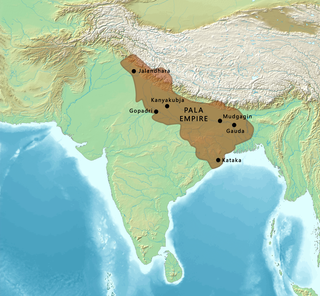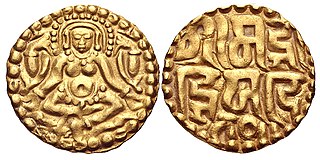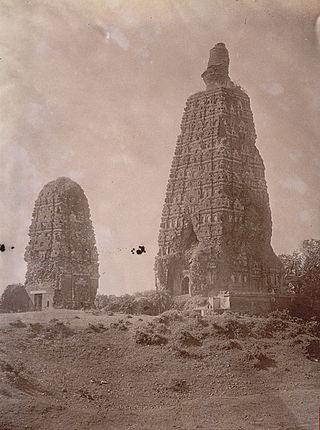
The Pāla Empire was an imperial power during the post-classical period in the Indian subcontinent, which originated in the region of Bengal. It is named after its ruling dynasty, whose rulers bore names ending with the suffix Pāla. The empire was founded with the election of Gopāla as the emperor of Gauda in late eighth century CE. The Pala stronghold was located in Bengal and eastern Bihar, which included the major cities of Gauḍa, Vikramapura, Pāṭaliputra, Monghyr, Somapura, Ramavati (Varendra), Tāmralipta and Jaggadala.

The Sena dynasty was a Hindu dynasty during the early medieval period on the Indian subcontinent, that ruled from Bengal through the 11th and 12th centuries. The empire at its peak covered much of the north-eastern region of the Indian subcontinent. The rulers of the Sena Dynasty traced their origin to the south Indian region of Karnataka.

The history of Bihar is one of the most varied in India.Chirand, on the northern bank of the Ganga River, in Saran district, has an archaeological record dating from the Neolithic age. Regions of Bihar—such as Magadha, Mithila and Anga—are mentioned in religious texts and epics of ancient India. Mithila is believed to be the centre of Indian power in the Later Vedic period. Mithila first gained prominence after the establishment of the ancient Videha Kingdom. The kings of the Videha were called Janakas. A daughter of one of the Janaks of Mithila, Sita, is mentioned as consort of Lord Rama in the Hindu epic Ramayana. The kingdom later became incorporated into the Vajjika League which had its capital in the city of Vaishali, which is also in Mithila.
The migrations of people and influences to the North from Karnataka during 7th-12th century period is well attested by the sources but has not yet been studied carefully. This is known as "The Great Karnataka expansion"
Gopala was the founder of the Pala dynasty of Bengal region of the Indian subcontinent. The last morpheme of his name Pala means "protector" and was used as an ending for the names of all the Pala monarchs. Pala does not suggest or indicate any ethnic or caste considerations of the Pala dynasty. He came to power in later half of eighth century AD in Gaur/Gaud after being elected by a group of regional chieftains.
Mithila is a geographical and cultural region located in the Indian subcontinent. The native language is known as Maithili and its speakers are referred to as Maithils. The majority of the Mithila region falls within modern-day India, more specifically in the state of Bihar. Mithila is bounded in the north by the Himalayas, and in the south, west and east by the Ganges, Gandaki and Mahananda respectively. It extends into the southeastern Terai of Nepal. This region was also called Tirabhukti, the ancient name of Tirhut.
Vigrahapala was a 9th-century ruler of the Pala dynasty, in the Bengal region of the Indian subcontinent. He was the sixth Pala emperor. He reigned for a brief period before becoming an ascetic. Vigrahapala was a grandson of Dharmapala's younger brother Vakapala and son of Jayapala. He was succeeded by his son, Narayanapala.
Madanapala was the successor to the Pala king Gopala IV in the Bengal region of the Indian subcontinent, and eighteenth and final ruler of Pala lineage reigning for 18 years. He was succeeded by Govindapala, whose lineage of that name is questionable.
Vijaya Sena, also known as Vijay Sen in vernacular literature, was the son of Hemanta Sena, and succeeded him as a Sena dynasty ruler of Bengal region of the Indian subcontinent. This dynasty ruled for more than 200 years. He conquered Bengal, fighting the kings of Gauda, Kamarupa, and Kalinga. He had a capital in Vijayapuri and Vikramapura.

Chinnamasta Bhagawati also called Shakhada Bhagawati and Shakhadeswori is a temple and Shakti Peethas in Eastern Nepal. It was established in 13th century by Shaktisimhadeva, the fifth ruler of the Karnata dynasty. The temple is in Chhinnamasta Rural Municipality, Saptari, 10 km from Rajbiraj near the Indian border. It is the oldest and most revered religious site in the Saptari district and draws thousands of devotees from Nepal and India during Bada Dashain and other festivals to worship the Hindu goddess Bhagawati.

The Kalachuris of Tripuri, also known the Kalachuris of Chedi, ruled parts of central India during 7th to 13th centuries. They are also known as the Later Kalachuris to distinguish them from their earlier namesakes, especially the Kalachuris of Mahishmati. Their core territory included the historical Chedi region, and their capital was located at Tripuri.

Gangeyadeva was a ruler of the Kalachuri dynasty of Tripuri in central India. His kingdom was centered around the Chedi or Dahala region in present-day Madhya Pradesh.
Lakshmikarna, also known as Karna, was a ruler of the Kalachuri dynasty of Tripuri in central India. His kingdom was centered around the Chedi or Dahala region in present-day Madhya Pradesh.
Harisimhadeva was a King of the Karnat dynasty who ruled the Mithila region of modern-day parts of South Nepal and North Bihar in India.
The Oiniwar dynasty, or Oiṇīvāra dynasty also known as the Sugauna dynasty, was a Maithil ruling dynasty of territories that form part of the Mithila region of the Indian subcontinent. They governed the area between 1325 and 1526, being preceded by the Karnat dynasty. Following the demise of the dynasty, emerged the dynasty of the Raj Darbhanga. One of the Oiniwar Dynasty's most notable rulers was Shivasimha who was known for his patronisation of the art as well as leading military campaigns against neighbouring polities.
Nanyadeva was the founder of the Karnat dynasty of Mithila. He established his capital in Simraungadh and ruled the greater Mithila region for 50 years. He is known for his generosity, courage, and patronage of scholars. He was from Karnat Kshatriya Kula and began to rule Mithila from Simraungadh in 1097 CE. The stone inscription found at Simraongarh and Nepālavaṃśāvalī clearly states that he made an erection in a Singha Lagna of a Saturday in a Sravana, the tithi being Sukla seven and the Naksatara Svati in the year 1019 Shaka.
The Karnats of Mithila or Karnata dynasty was a dynasty established in 1097 CE by Nanyadeva. The dynasty had its main stronghold in the citadel of Simraungadh which was situated on the Bihar-Nepal border with excavations showing that parts of the fort were situated in what is now Indian territory while the rest falls within what is now Nepalese territory. The city of Darbhanga also became the second capital during the reign of Gangadeva. The kingdom controlled the areas we today know as Tirhut or Mithila in the Bihar state of India and Nepal. This region is bounded by the Mahananda River in the east, the Ganges in the south, the Gandaki River in the west and by the Himalayas in the North. Under the Karnats, Mithila enjoyed almost full sovereignty from 1097 until 1324.
Narasimhadeva was the third King of the Karnat dynasty of Mithila. Most scholars agree that he came into power around 1174 CE and succeeded his predecessor, Gangadeva.
Malladeva was the son of King Nanyadeva from the Karnat dynasty, and a prince of Mithila. According to some scholars, Malladeva has been referred to as the "forgotten King of Mithila" as most records and traditions mention that his brother Gangadeva succeeded his father as ruler of the dynasty. Nevertheless, Malladeva seems to have founded his own stronghold in the village of Bheet-Bhagwanpur in Darbhanga in modern-day Bihar, India. In the village, an inscription was found which read "Om Shree Malladevasya" and many Karnat-era sculptures have been found in the area.

The Pīṭhīpatis of Bodh Gaya were the rulers of the area around Bodh Gaya from roughly the 11th to 13th centuries in the Magadha region of what is now Bihar in India. Pithi refers to the diamond throne where the Buddha was said to have gained enlightenment.





